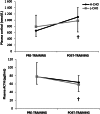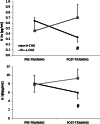Impact of intensified training and carbohydrate supplementation on immunity and markers of overreaching in highly trained cyclists
- PMID: 26908041
- PMCID: PMC4834106
- DOI: 10.1007/s00421-016-3340-z
Impact of intensified training and carbohydrate supplementation on immunity and markers of overreaching in highly trained cyclists
Abstract
Purpose: To determine effects of intensified training (IT) and carbohydrate supplementation on overreaching and immunity.
Methods: In a randomized, double-blind, crossover design, 13 male cyclists (age 25 ± 6 years, VO2max 72 ± 5 ml/kg/min) completed two 8-day periods of IT. On one occasion, participants ingested 2 % carbohydrate (L-CHO) beverages before, during and after training sessions. On the second occasion, 6 % carbohydrate (H-CHO) solutions were ingested before, during and after training, with the addition of 20 g of protein in the post-exercise beverage. Blood samples were collected before and immediately after incremental exercise to fatigue on days 1 and 9.
Results: In both trials, IT resulted in decreased peak power (375 ± 37 vs. 391 ± 37 W, P < 0.001), maximal heart rate (179 ± 8 vs. 190 ± 10 bpm, P < 0.001) and haematocrit (39 ± 2 vs. 42 ± 2 %, P < 0.001), and increased plasma volume (P < 0.001). Resting plasma cortisol increased while plasma ACTH decreased following IT (P < 0.05), with no between-trial differences. Following IT, antigen-stimulated whole blood culture production of IL-1α was higher in L-CHO than H-CHO (0.70 (95 % CI 0.52-0.95) pg/ml versus 0.33 (0.24-0.45) pg/ml, P < 0.01), as was production of IL-1β (9.3 (95 % CI 7-10.4) pg/ml versus 6.0 (5.0-7.8) pg/ml, P < 0.05). Circulating total leukocytes (P < 0.05) and neutrophils (P < 0.01) at rest increased following IT, as did neutrophil:lymphocyte ratio and percentage CD4+ lymphocytes (P < 0.05), with no between-trial differences.
Conclusion: IT resulted in symptoms consistent with overreaching, although immunological changes were modest. Higher carbohydrate intake was not able to alleviate physiological/immunological disturbances.
Keywords: ACTH; Cortisol; Cytokine; Interleukin; Lymphocyte; Overreaching.
Figures






Similar articles
-
Effects of carbohydrate supplementation on performance and carbohydrate oxidation after intensified cycling training.J Appl Physiol (1985). 2004 Oct;97(4):1245-53. doi: 10.1152/japplphysiol.01368.2003. Epub 2004 May 21. J Appl Physiol (1985). 2004. PMID: 15155717 Clinical Trial.
-
The impact of intensified training with a high or moderate carbohydrate feeding strategy on resting and exercise-induced oxidative stress.Eur J Appl Physiol. 2015 Aug;115(8):1757-67. doi: 10.1007/s00421-015-3162-4. Epub 2015 Mar 31. Eur J Appl Physiol. 2015. PMID: 25822694 Review.
-
Supplemental Protein during Heavy Cycling Training and Recovery Impacts Skeletal Muscle and Heart Rate Responses but Not Performance.Nutrients. 2016 Sep 7;8(9):550. doi: 10.3390/nu8090550. Nutrients. 2016. PMID: 27618091 Free PMC article. Clinical Trial.
-
Protein intake during training sessions has no effect on performance and recovery during a strenuous training camp for elite cyclists.J Int Soc Sports Nutr. 2016 Mar 5;13:9. doi: 10.1186/s12970-016-0120-4. eCollection 2016. J Int Soc Sports Nutr. 2016. PMID: 26949378 Free PMC article. Clinical Trial.
-
Exercise and immune function. Recent developments.Sports Med. 1999 Feb;27(2):73-80. doi: 10.2165/00007256-199927020-00001. Sports Med. 1999. PMID: 10091272 Review.
Cited by
-
Block vs. Traditional Periodization of HIT: Two Different Paths to Success for the World's Best Cross-Country Skier.Front Physiol. 2019 Apr 5;10:375. doi: 10.3389/fphys.2019.00375. eCollection 2019. Front Physiol. 2019. PMID: 31024338 Free PMC article.
-
The Effect of Gut-Training and Feeding-Challenge on Markers of Gastrointestinal Status in Response to Endurance Exercise: A Systematic Literature Review.Sports Med. 2023 Jun;53(6):1175-1200. doi: 10.1007/s40279-023-01841-0. Epub 2023 Apr 15. Sports Med. 2023. PMID: 37061651 Free PMC article.
-
Overtraining Syndrome (OTS) and Relative Energy Deficiency in Sport (RED-S): Shared Pathways, Symptoms and Complexities.Sports Med. 2021 Nov;51(11):2251-2280. doi: 10.1007/s40279-021-01491-0. Epub 2021 Jun 28. Sports Med. 2021. PMID: 34181189 Review.
-
The Stress of Competing: Cortisol and Amylase Response to Training and Competition.J Funct Morphol Kinesiol. 2021 Jan 4;6(1):5. doi: 10.3390/jfmk6010005. J Funct Morphol Kinesiol. 2021. PMID: 33462167 Free PMC article.
-
A Practical Approach to Monitoring Biomarkers of Inflammation and Muscle Damage in Youth Soccer Players During a 6-Month Training Cycle.J Hum Kinet. 2021 Oct 31;80:185-197. doi: 10.2478/hukin-2021-0093. eCollection 2021 Oct. J Hum Kinet. 2021. PMID: 34868428 Free PMC article.
References
-
- Brouwer E. On simple formulae for calculating the heat expenditure and the quantities of carbohydrate and fat oxidized in metabolism of men and animals, from gaseous exchange (Oxygen intake and carbonic acid output) and urine-N. Acta Physiol Pharmacol Neerl. 1957;6:795–802. - PubMed
Publication types
MeSH terms
Substances
LinkOut - more resources
Full Text Sources
Other Literature Sources
Medical
Research Materials

